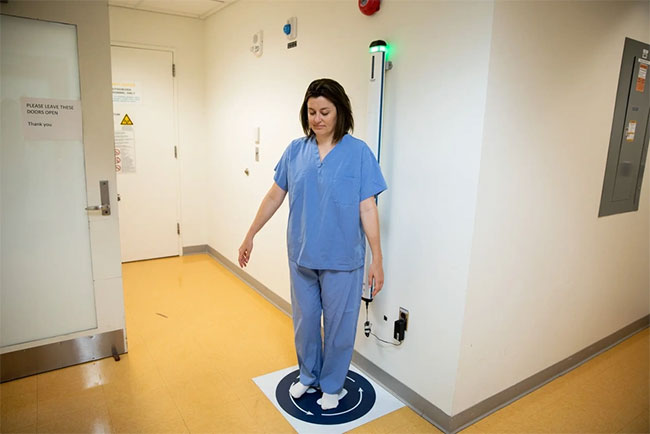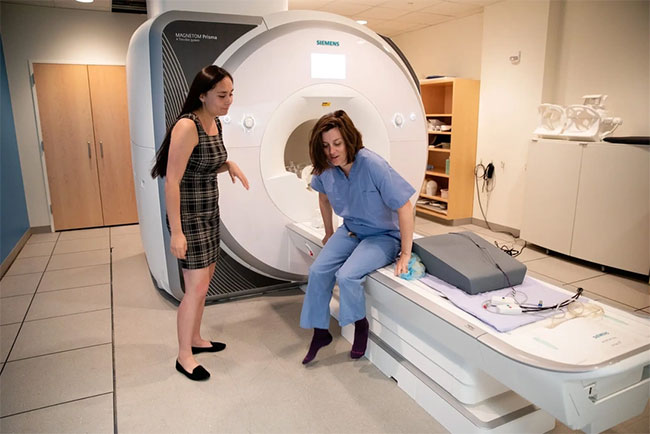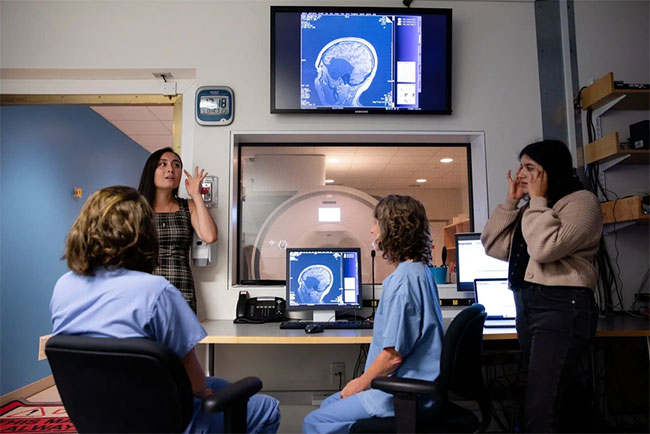“I was born without a left temporal lobe, the part of the brain associated with many behaviors, from memory to emotional recognition, and especially language.”
| The article in The New York Times tells the story of Helen Santoro, who became the subject of research for much of her life due to being born without a left temporal lobe, a region of the brain considered crucial for language. |

The girl on the left is Helen Santoro, examining brain scans with her mother at the Massachusetts Institute of Technology lab in Cambridge, Massachusetts, in July. (Photo: Kayana Szymczak, The New York Times).
I was born in a hospital in New York City late at night.
In the first few hours of my life, after six apnea episodes, doctors took me to the neonatal intensive care unit. An intern put her pinky finger in my mouth to test my newborn sucking reflex. I wasn’t sucking strongly enough. So, they rolled my nearly 3.5 kg pink body into a brain scanner.
On the screen appeared a very large hole on the left side, right above my ear. I lacked a left temporal lobe, a region of the brain associated with many behaviors, from memory to emotional recognition, and especially language.
My mother was exhausted after giving birth. When she woke up, she was informed by a neurologist, a pediatrician, and a midwife that my brain had bled in her womb, a condition known as perinatal stroke.
They told her I would never speak and would need lifelong hospital treatment.
In the early days of my life, my parents wondered what my life and theirs would be like. Eager to find answers, they enrolled me in a research project at New York University to track perinatal stroke.
However, after several months, I surprised experts by achieving all the typical milestones like my peers. I enrolled in school, excelling in sports and academics. The language skills such as speaking, reading, and writing that the doctors were most concerned about turned out to be my professional passion.
My case is very unusual but not unique. Scientists estimate that thousands of people, like me, live normal lives despite missing a large part of their brains. How did our network of countless neurons manage to adapt?

Helen Santoro is passionate about language, despite being born without a left temporal lobe, a region of the brain crucial for language. (Photo: Kayana Szymczak/The New York Times).
“The Worst Research Participant”
My childhood memories are filled with images of researchers always watching me. They scanned my brain multiple times a year, and I was assigned to solve countless puzzles, search for words, and test image recognition. At the end of each testing day, researchers would give me a sticker, which I kept in a tin box beside my bed.
When I was 9 years old, researchers wanted to see how my brain would function when I was exhausted. Sometimes I stayed up all night with my mother, eating Chinese food and watching films starring Katharine Hepburn and Spencer Tracy.
The next day, I would walk into the clinic half-awake. Scientists would attach electrodes to my scalp. When they finished connecting the electrodes, making my head look like Medusa, I was finally allowed to sleep, unaware that researchers were looking for unusual patterns in my brain waves.
Over the years, scientists realized that I was different from other children in the study because I had no deficits to track.
When I was about 15, my father and I met Dr. Ruth Nass, the pediatric neurologist leading the research. She wondered if I had truly experienced a perinatal stroke. She also candidly stated that my brain was so different that I could no longer participate in the study.
I didn’t mind much. I had plenty of other things in life, like starting high school, studying abroad, and dating. I was also very interested in neuroscience because I had been exposed to the subject for so long.
When I was 17 and entering my senior year of high school, I wrote a letter to Dr. Nass asking if I could intern in her lab. She agreed.

Hope Kean, a graduate student at the Massachusetts Institute of Technology, prepares to take Helen Santoro into the MRI machine. (Photo: Kayana Szymczak/The New York Times).
One day, I asked her if she could show me my research records. We walked into a room filled with plastic bins, each containing stacks of documents and papers. She picked up a folder and read silently. Then she said: “You are the worst participant because you are completely fine! All this data is worthless now.”
Dr. Nass, who passed away in 2019, and her colleagues continued to publish numerous studies on perinatal stroke. For example, in a 2012 paper, they found that infants who experienced strokes were at higher risk of behavioral and attention problems compared to children in general.
Many of these children – selected from 1983 to 2006 from Southern California and New York City – experienced seizures and muscle weakness on one side of the body. Most also had damaged or absent areas in the left hemisphere, just like me.
I majored in neuroscience. After graduating in 2015, I spent two years working in a lab researching concussions. I spent hours in the MRI room, observing other people’s brains on computer screens.
But I never thought much about my own brain until this spring when I stumbled upon a story in Wired about a woman like me: remarkably normal, even with a missing left temporal lobe.

Helen Santoro undergoing cognitive testing at the Massachusetts Institute of Technology. (Photo: Kayana Szymczak, The New York Times).
The Important Hemisphere
For over a century, the left hemisphere of the brain has been regarded as the center for language production and comprehension.
This idea was first proposed in 1836 by Dr. Marc Dax. He observed patients with injuries to the left side of the brain who could not speak normally.
Twenty-five years later, Dr. Pierre Paul Broca observed a young man who lost the ability to speak and could only utter one syllable: “Tan.” A post-mortem brain biopsy of the patient revealed a large lesion in the front part of the left hemisphere, now known as Broca’s area.
In the early 1870s, Dr. Carl Wernicke, a neurologist, found that some patients could speak fluently, but their speech was nonsensical. One of these patients had a stroke in the posterior left temporal lobe, and Dr. Wernicke concluded that this part of the brain – now known as Wernicke’s area – certainly serves as a second language center, along with Broca’s area.
Modern brain imaging studies have expanded our understanding of language. Much of this work indicates that two brain regions – the left temporal lobe and the frontal lobe – activate when we read or hear words. Some researchers refer to this as the “language network.”
But other neuroscientists argue that the process of language processing is even broader and not limited to specific brain regions.
Jeremy Skipper, head of the Language, Action, and Brain Lab at University College London, states: “I believe that language-related abilities are distributed throughout the brain.”
Studies show that written words can activate parts of the brain related to the meanings of those words. For example, the word “phone” activates the area related to hearing, “stone” activates the area related to foot movement, and “garlic” activates the olfactory system.

Helen Santoro participating in the Interesting Brain Project. (Photo: Kayana Szymczak/The New York Times).
Eight Interesting Brains
The article in Wired describes an anonymous woman from Connecticut who was unaware that she lacked a left temporal lobe until she underwent a brain scan. For several years, the article explains, she was part of a research project led by Evelina Fedorenko, a cognitive neuroscientist at the Massachusetts Institute of Technology.
In April, I wrote to Dr. Fedorenko, informing her about my missing left temporal lobe and expressing my interest in participating in the research. There are currently eight participants, including myself, in Dr. Fedorenko’s Interesting Brain Project.
I have not met them yet, but four of us are said to have experienced perinatal strokes, resulting in damage to the left hemisphere of the brain. Two others have benign cysts in the right or left hemisphere, one person had a stroke in the right hemisphere, and another had brain tissue removed from the left hemisphere due to a tumor.
Hope Kean, a graduate student in Dr. Fedorenko’s lab who is conducting the Interesting Brain Project for her thesis, stated: “The brain has an astonishingly flexible neural capacity.”
“Ms. Kean mentioned that it seems like the networks in the brain are organized in a certain structure, but if you lose an important region of the brain when you are young, while the brain is still very plastic, these networks can reroute themselves.”
I visited Dr. Fedorenko’s lab in Cambridge on a hot July day. I lay on a sliding bed into the MRI machine with a device placed on my head. Ms. Kean held up a mirror on my head so I could see the screen behind the scanner. As the machine began to emit loud banging noises, I recalled all the times I had dozed off as a child, lulled to sleep by this thunderous sound.
On the screen, words flashed rapidly, accompanied by a voice reading them aloud, forming random sentences such as: “Only the slightest hint of a heel on the teenage shoes.” Then, the words shifted to a jumble of letters, producing unintelligible sounds.
After the scan, the researchers and I gathered around the computer screen, where I saw my brain for the first time. I stared in astonishment at how the neural pathways could reroute around such a large hole in my head.

Hope Kean, a graduate student at the Massachusetts Institute of Technology, assists Helen Santoro out of the MRI machine. (Photo: Kayana Szymczak/The New York Times).
In a normal human brain, meaningful sentences in the scanner strongly activate the left frontal and temporal lobes, while nonsensical sounds do not.
A study published in the journal Neuropsychologia showed that the brain of an anonymous patient in Connecticut had adapted by switching sides: For her, meaningful sentences activated the right temporal and frontal lobes.
However, my brain surprised everyone.
Preliminary analysis of the scan results indicated that even without a left temporal lobe, I still processed sentences using my left hemisphere.
Dr. Fedorenko remarked: “I thought that any early damage to the left hemisphere would lead to a shift of the language system to the right hemisphere!”
According to Dr. Fedorenko, the reason might be that my damage was primarily in the front of the left hemisphere, while the posterior regions remained strong enough to develop the language system.
In the coming years, I will fly back to the lab for further scans and assessments, and Dr. Fedorenko hopes to find more individuals with unusual brains to participate in this research.
I still think about the study I participated in as a child and about all the other children who suffered perinatal strokes, many of whom ended up severely disabled. For some mysterious reason, my brain developed around the missing lobe, while others struggled to do so.
Why was I not born with developmental and cognitive issues? Why did my left side reroute itself, allowing me to develop a richer language ability? It is these questions that make me grateful to have participated in this research and to be one of the study subjects.

Helen Santoro, sitting on the left next to her mother, listens to Hope Kean discuss her brain scan with research assistant Niharika Jhingan, in July. (Photo: Kayana Szymczak/The New York Times).



















































